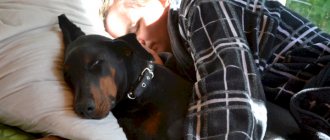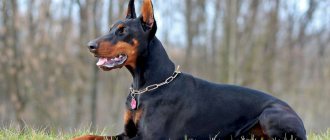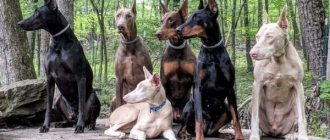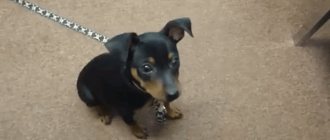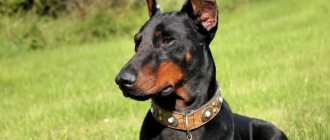The Doberman is a smooth-haired working dog characterized by an elegant, noble exterior. The animal faithfully guards its owner and quickly makes decisions in any situation. People speak differently about this breed. Some people consider the dog aggressive and not meant to be kept at home. Others talk about the Doberman's good searching abilities.
The Doberman is a devoted service dog.
Brief data
Name: Doberman.
Country where the breed was bred: Germany.
Date of appearance of the Doberman: 1890
Height: up to 72 cm (males), up to 68 cm (females).
Body weight: 45 kg (males), 35 kg (females).
How long do Dobermans live: up to 14 years.
Historical reference
The white Doberman was artificially bred in the 70s of the 20th century.
For the first time, a female of the usual dark brown color gave birth to an albino puppy in 1976. Once the puppy reached reproductive age, attempts were made to cross the born albino bitch with a Doberman male of normal color. The experiment was not a success: the puppy was born brown.
White Dobermans are considered very rare.
Subsequently, an albino puppy was nevertheless born after mating a white mother with her normal-colored son.
All white representatives of the breed in the United States are descendants of the first albino bitch. Therefore, white people are considered an incomplete albino.
Facts about the breed
The future owner of a Doberman will be interested to know that:
Dobermans can become guard dogs.
The breed is considered universal. The Doberman is capable of becoming a reliable guard, companion, hunting companion, and pet. The animal is included in the lists of the most popular breeds.- The Dobermann dog faithfully serves its owner and his family members. The dog is friendly towards familiar animals and people. Despite the increased activity and temperament, the animal vigilantly monitors what is happening and is always ready to rush to the defense of the owner.
- The dog requires increased exercise. She is characterized by good learning ability and excellent working qualities. To develop these natural abilities, you need to raise your Doberman correctly.
- High intellectual abilities, endurance and a desire to learn new things allow the dog to easily master commands. An experienced instructor can achieve amazing results. The Doberman can do everything, and this is not an exaggeration.
- Despite good natural characteristics and working characteristics, the breed is not suitable for everyone. A person who is too calm and indifferent or irritable will not be able to properly raise this dog and appreciate its merits.
- A dog's natural instinct helps him to separate good from bad, regardless of whether it concerns his owner or what is happening around him.
- The Doberman is considered an animal with a stable psyche. Proper training can bring out the best qualities of this dog.
- People unfamiliar with the breed consider Dobermans to be angry or overly noisy. However, it is not. Aggression occurs only when a dog is raised and raised in unfavorable conditions.
- The Doberman is considered an aristocratic animal. The owners are proud of their smart, loyal and strong dogs. The noble appearance becomes a pleasant addition.
The Doberman is included in the list of the 20 most popular breeds. When a person begins to study information about this dog, he wonders what he is famous for. Residents of St. Petersburg tell the story of Trefa, a service Doberman who worked in the police at the beginning of the last century. The dog has helped solve more than 1,500 cases. Experts believe that the poet Sergei Yesenin wrote about the Doberman.
The great Russian actor Vasily Kachalov had a dog of this breed. There are many other stories and legends about this dog.
Application
This dog needs constant activity.
The Doberman Pinscher will, with equal zeal, accompany its owner on a hunt, save people from rubble, follow a trail, or babysit children.
Dobermans are versatile dogs, they are used for:
— protection of important objects and private territories;
- police and customs services;
— search and rescue operations.
The Doberman Pinscher is well suited for agility , traveling, and playing with children.
But if adults do not plan to raise a dog, then the Doberman Pinscher is not the best choice of a pet for a child.
Dogs are distinguished by: courage, loyalty, attentiveness and fearlessness. They become strongly attached to their owners and protect them in any conditions.
For those who are not ready to devote a lot of time to raising this dog, there is a wonderful alternative - the mini Doberman Pinscher.
This is the name of the miniature pinscher. And although these are completely different breeds, they have a lot in common in appearance.
Origin of the Doberman
The name of the breed comes from the name of its creator. Karl Dobermann lived in a small German town and constantly changed professions. He served as both a night policeman and a tax collector. At that time, Karl thought about creating a breed that would have better performance characteristics. Dobermann believed that a dog should be of average height, smooth coat, high intelligence, alertness and endurance. Karl constantly attended animal exhibitions that were held in Apolda. From the animals presented, he selected those that had the best characteristics.
The dog has a smooth coat, high intelligence and endurance.
At the end of the 19th century, Dobermann purchased a house, where, together with his friends, he began to create a new breed. The experiments ended successfully. Numerous animal lovers bought dogs from Karl. There is no information about what breeds were crossed to produce the Doberman. The breeder did not keep any notes during his work. Some scientists believe that the ancestors of the Doberman are shepherd dogs, German pinschers, and Rottweilers. Perhaps the Blue Great Dane, Black Terrier, Pointer and Mastiff left their genetic traces.
As a result of the experiments, a dog with pronounced working characteristics was bred. In the 19th century the breed was called the Thuringian Pinscher. Another resident of Apolda, Otto Holler, was closely involved in improving its characteristics. The dog breeder was able to eliminate excessive aggression and make the animal softer. The guarding and protective qualities of the Doberman were not affected.
There have been some curious cases in the history of Doberman development. Otto Holler's neighbor was unhappy with the constant noise and barking coming from a nearby house. The dog breeder had to give away most of the animals, leaving a couple of representatives of the bred breed.
This situation contributed to the spread of Dobermans and increased their popularity.
After Dobermann's death, the breed was named in his honor. In 1897, a show took place where a new dog was presented. In 1899, the first Apolda Doberman Pinscher fan club was opened. Within a year, the whole of Germany learned about the club. The breed began to actively spread throughout Europe, then throughout the world. Dobermans were brought to our country at the beginning of the 20th century. In 1994, the Canine Federation entered the name “Doberman” into the register and indicated Germany as the place of origin.
Price examples
As already mentioned, you can buy a dog for 8,000 or 100,000 rubles. Now you know what factors influence price formation. Let's take two specific examples to fully grasp the information and analyze the data.
- A Doberman puppy is sold in Moscow, show class (the most expensive) for 50,000 rubles. This is not to say that the litter is valuable, but the class is high. This will be a pearl, because the breed is often exhibited at exhibitions. It is difficult to find such a dog without documents.
- The puppy is sold in Chelyabinsk for 20,000 rubles, pet class. All necessary documents are available. If there is little demand in the city, then the price will be reduced, and the availability of papers is important, because sales in the provinces are often carried out without them.
Appearance of the animal
The Doberman is a medium-sized dog with a powerful, muscular body, combining noble posture, graceful and clear lines.
The appearance of the animal is distinguished by elegant and clear lines.
The dog has the best anatomical structure. The entire exterior is visible, so it’s difficult to hide flaws. The combination of power, large reserves of internal energy, external grace and aristocratic sophistication gives a good impression of the Doberman.
Main settings
The height of a male at the withers reaches 72 cm, that of a female - 68 cm. Deviations upward or downward of more than 2 cm are considered a significant fault. An adult male Doberman weighs 40-45 kg, a female – 32-35 kg. The Doberman has average parameters and a harmonious build. There are no signs of rough outline or excessive massiveness of the body. The dog is more square than elongated. The height at the withers is approximately equal to the length of the body.
Head
This part of the body corresponds to the general dimensions. When viewed from above, the shape of the head resembles a blunt wedge. The top line from the front looks even and does not fall towards the ears. The transition between the forehead and nose is visible, but not very pronounced. The jaw muscles are well developed, the dog has no cheeks.
Muzzle
The length of this part practically coincides with the corresponding parameter of the skull. The opening of the mouth reaches the molars. The opening of the mouth is wide. The nose ends in a large, but not protruding, black lobe. Lighter shades are allowed if the animal has the appropriate color.
The jaw muscles on the muzzle are well developed.
Dry lips fit tightly to powerful, wide jaws. A scissors bite is considered correct.
Eyes and ears
The eye shape is oval, medium length. The iris is dark brown. Light Dobermans may have other eye colors. Dobermans have high-set ears. After docking, they stand upright. In some countries, such procedures are prohibited. Dobermans' undocked ears hang down, but do not fit too tightly to the head.
Frame
The dog has a straight, long neck with well-developed muscles. The back begins with prominent withers. The lumbar region is short. For bitches, slight elongation of this part of the body is allowed. The croup is rounded. The chest is wide and convex, with slightly prominent ribs. Its anterior part is well developed. The optimal depth of the chest is equal to half the height of the animal.
Tail
This part of the dog's body is set high. When docking, only 2 vertebrae are left. If such a procedure is prohibited, a natural tail is left.
The Doberman's tail is set high.
Paws
The stance of the forelimbs is straight and vertical. The muscles are well developed. The hind limbs are set parallel. Most of the muscles are concentrated in the thigh area. Both the front and hind legs are short, with arched toes that form a ball and end in dark, thick claws.
Wool
The Doberman's hair is short, smooth, and stiff. It fits tightly to the skin and is evenly distributed throughout the body. This breed has no undercoat.
Color
The standards recognize black or brown Dobermans. The presence of red spots with clear boundaries is mandatory.
Breed defects
The following defects in the dog’s appearance can be defects of the breed:
- the presence of soft and wavy hair;
- the appearance of light or darkened tan marks, white marks;
- the presence of thick and clearly visible undercoat;
- amble;
- the presence of proximity of the hock joints, incorrect angles of joints and dewclaws;
- the presence of twisted elbows, clubfoot or dislocation;
- lack of muscles;
- formation of a barrel-shaped, flat or narrow chest;
- the presence of bulging eyes, as well as a thick and short neck with a dewlap.
Among other things, shortcomings can be represented by a convex frontal part or bridge of the nose, a sharp transition or its complete absence, a heavy and short head, high cheekbones, a sharp muzzle, thick lips and low-set ears.
Disqualifying Faults
Significant defects due to which a dog is not allowed to participate in exhibitions are:
- discrepancy between the appearance and gender of the animal (female in male type and vice versa);
- yellow or blue eyes;
- malocclusion;
- wavy or elongated coat;
- presence of hairless areas;
- white spots;
- lack of teeth;
- excessive nervousness, cowardice, aggression.
Excessive nervousness is a disqualifying fault.
Owner reviews
Dobermanns talk about their favorite pets like this:
“My favorite pie! This is my-my dog."
“If you still decide to adopt a Doberman, then, with proper training, you will get a very smart, kind dog, attached to its owner.”
“She, of course, is an infection... But she is so beloved!!!”
“Before getting a Dober, you need to weigh the pros and cons. Dobermanns probably require more time for training and attention than anyone else, but this is only due to the fact that they are very people-oriented and are ready to do anything to get attention.”
“Once you get to know this breed, you don’t need another!”
Dog character
Some people don't know what to expect from a Doberman, which has mixed reviews. The main character trait of this animal is vigilance. The dog constantly closely monitors what is happening around. Increased caution is not a consequence of intimidation or cowardice. This is how genetically endowed thinking abilities manifest themselves in a dog. Increased vigilance is the result of intellectual activity. Although there are common character traits, each dog represents a separate personality.
Some dog experts compare the Doberman to a human. The dog easily remembers commands and never forgets them. However, only a calm, balanced, intelligent owner can eliminate negative character traits and properly educate and raise a Doberman.
To be convinced of the unusualness of this dog, you need to observe its behavior. The owner believes that the dog drives, sleeps, walks and plays with him. The Doberman himself believes that he is in his own home, sitting on his own chair. Everything is perceived by this dog as personal, within its sphere of influence. The Doberman should be the first to know about events happening in the house. The owner, in his opinion, only gives him everything he needs for a comfortable life.
The dog was bred to perform service tasks. Working Dobermans were brought up to be unquestioningly obedient to their owners and aggressive towards strangers. This strengthened the opinion about the viciousness and inadequacy of these animals. However, breeders were able to eliminate negative characteristics and maintain working qualities. Modern Dobermans can be raised as pets.
The dog's character is alert and active.
You cannot use a dog's natural qualities (fearlessness, strength, activity and intelligence) to raise a monster. A feature of the breed is that the animal independently looks for the difference between good and bad. You cannot raise and train a dog by suppressing it. The Doberman is an intelligent, loyal friend. The dog can become the pet that the owner has always dreamed of.
Search on Avito
The popular site is replete with advertisements for the sale of animals and their photographs. Pets are distributed in this way by professional breeders, amateur dog breeders and scammers.
For a reasonable price you can find a worthy purebred representative, or it is also possible to become a victim of fraud. Often, mestizos are sold under the guise of purebred dogs; even a breed connoisseur can find it difficult to identify inconsistencies among small puppies. Of course, a mixed breed can become a faithful companion, but it’s a shame to pay an unreasonable amount; you can get a faithful outbred dog for nothing.
If you buy from an ad, you may encounter a replacement puppy. A photo of a cute purebred baby is displayed on the site, but in fact another one is being sold, and the seller says that “yours” was just bought, and “this one” will soon be taken away too. The buyer, obeying the initial impulse to buy a dog, agrees to what is offered to him. Therefore, before your trip, contact the seller and ask to send a new photo or video; the scammer will probably not fulfill the request and will stop answering calls.
Education and training of the Doberman
Raising a dog is not difficult, but you shouldn’t think that you can raise a pet that understands commands without doing anything about it. Doberman training begins at an early age. First you need to show the puppy who is the leader and owner. Without strengthening his authority, the owner will not achieve the desired result. The dog is smart, he will not follow a person’s commands if he does not recognize his superiority.
Persistence, discipline and adherence to the order of actions are the main principles of dog training. You need to patiently instill the ability to follow commands. However, violence cannot be used in raising a Doberman. The dog will consider a person who shows cruelty to be weak. He will not carry out the command. An intelligent dog may harbor a grudge and become aggressive later in life. The best tools will be persuasion and affection.
Loving a pet does not mean allowing it everything. Having decided not to feed the dog treats from his table or allow him to jump on the sofa, the owner should always do this. You cannot scold your pet for chewed shoes or torn wallpaper. He will not be able to establish a connection between the punishment and his own wrongdoing. In addition, the Doberman may harbor a grudge, which can cause his relationship with his owner to deteriorate. A pet should see a like-minded person and friend in a person.
Education and training of the Doberman begins at an early age.
It is necessary to properly structure the process of training a dog. In the first months, the puppy is taught the basic commands: “Place!”, “Come to me!”, “Sit!” For correct execution of commands, your pet should be rewarded with affection or a treat. During walks, the command “Come to me!” needs to be practiced many times, and not just before returning home. In this case, the pet will not associate the fulfillment of the request with the completion of an enjoyable event for him.
When training at home, you need to take into account the characteristics of the animal’s character: from the level of its activity to its food preferences. Conducting a full training course, especially raising a protective guard dog, should be entrusted to a professional dog handler.
A properly trained Doberman will become a loyal friend and assistant to its owner.
Walks
For proper socialization of the puppy, it is necessary to walk in places that allow him to get used to strangers and sounds. Those who like to travel by car are advised to accustom their dog to the car while still a puppy.
During walks, it is worth remembering that Dobermans, and especially males, love to get into fights with other dogs.
Pet care
The short-haired Doberman is well suited for keeping in apartments. If a dog is purchased for a private home, a spacious enclosure with a booth is built as a home for it. In cold weather, it is better to let the dog indoors. The enclosure is located in a shaded area, since the Doberman does not do well in the heat. The earthen floor is covered with wooden boards installed on supports 10-20 cm thick. If possible, a heating system is installed from a number of infrared heaters.
If the puppy lives in the house, a place to sleep is set up in a warm, clean room. The dog is extremely active; after a long run, it should not be allowed to lie down on an unheated floor. The dog may catch a cold, which will cause an unpleasant disease - muscle inflammation. There is no need to cancel your walk in rainy weather. However, after it the dog is taken into a heated room, where it dries and warms up.
Hygiene and bathing
The dog's coat does not require complex care. There is no need to comb it too often. Once a week, the dog’s body is wiped with a damp towel.
Bathing helps strengthen the animal's immunity.
After this, massage the skin with a stiff brush. Dobermans should not be bathed often. It is enough to carry out the procedure once every 6 months. Experienced dog breeders believe that frequent bathing weakens the immune system, which causes the animal to constantly become ill. It is safe to wash dirty paws after a walk.
Your pet's eyes and ears should be examined regularly. Any dirt that appears is removed with a cotton pad moistened with water. Nails are trimmed as needed. In an active dog, they gradually wear off during walks. Sleeping and eating areas must be kept clean. Food and water bowls are washed after each feeding.
The Doberman needs increased physical activity. The walk should last at least 2 hours. In the absence of warm clothing for dogs, the duration of walking in winter is reduced.
Dog food
It is allowed to feed Dobermans with natural products or ready-made diets. When creating a menu, adhere to the following recommendations:
- Premium dry food is intended for dogs with normal body weight. If a pet weighs more than 25 kg, it needs to be fed a diet that prevents the development of obesity.
- When a dog is fed natural products, most of the menu should consist of meat. The best variety is considered to be lean veal. An adult dog should consume at least 1 kg of this product per day. You cannot replace it with pork, offal or minced meat.
- The diet should include porridge cooked in water, vegetables (zucchini, pumpkin, carrots), and cottage cheese.
Solid food for older dogs is softened by soaking in kefir. This method is not used when feeding young animals.
Nutrition
One of the main expenses for owning a dog is buying food. How much money you need for food every month depends on the class of products. Cost of dry food per month:
- Economy - 2000;
- Premium - 3000;
- Super premium - 3500;
- Holistic - 4000.
If you add supplements used for encouragement and nutritional supplements to the main diet, you need to add another 30-50 rubles to the monthly amount spent on food. But these are averages. Small breed dogs are not able to eat a lot of food; their consumption will be 30% lower. If food allergies or gastrointestinal diseases develop, you need to switch to a hypoallergenic diet and costs will increase by 10-15%.
This problem of miscalculation is the inability to predict whether the selected type of food will suit the dog. Trying to combine food on your own in order to reduce the cost of your diet does not work. Feeding your pet human food is dangerous; the food is not 100% digestible. You will have to spend more money on diagnosis, treatment, and recovery.
Possible diseases and treatment
Regular preventive examinations and vaccinations help prolong the life of your pet. The Doberman is considered to be in good health.
Dobermans need to be examined regularly by a doctor.
However, some animal representatives are diagnosed with:
- Cardiovascular pathologies. Arrhythmia, tachycardia and ischemic heart disease are found even in young dogs. To detect the disease in time, you need to carefully monitor your pet’s health. You should contact a veterinarian if your Doberman is breathing heavily when at rest, trembling, walking unevenly, and falling. For heart disease, drug therapy is used. All medications must be taken with you on your walk. Heart disease can be hereditary. Symptoms in this case do not appear immediately. Advanced forms of pathology are more difficult to treat.
- Narcolepsy is a genetically determined neurological disorder in which muscle tone periodically decreases. At the same time, the dog falls and stops moving, its eyes glaze over. Stroking the body or clapping your hands helps bring the animal to its senses. What triggers the development of this disease is not fully understood. Following the veterinarian's instructions helps prevent attacks.
- Gastric volvulus. Occurs due to poor nutrition. Gastric volvulus is indicated by: drooling, constant bouts of vomiting, abdominal pain, and the urge to defecate. The animal becomes irritable. If there is a gastric volvulus, you must immediately contact a veterinarian, otherwise the dog may die.
- Allergic reactions. Caused by pollen, house dust, microscopic fungi. A dangerous complication of allergies in Dobermans is considered to be licking sacral granuloma. The disease is difficult to treat and most often requires surgical intervention.
Infections and helminthic infestations are common in dogs of any breed. Regular vaccinations and deworming help to avoid them.
Buying "from hand"
The advantage of this method of purchasing an animal is that it costs relatively little. At the market there are resellers called “breeders”; some sellers bring dogs whose breed and health they know nothing about. Although the price tags are lower than in dog breeding organizations, there is a risk of loss in purchasing a non-purebred or sick animal, which can be adopted for free.
To avoid becoming a victim of deception, you need to have a good understanding of the exterior of purebred animals and be able to visually recognize signs of disease. Try to find out the seller's address so you can contact him if any misunderstandings arise.
How to choose a puppy
Every owner wants to buy a smart and loyal Doberman. The future relationship between a person and a dog largely depends on the right choice of animal. Animals should only be purchased from trusted breeders and nurseries. Purchasing a puppy through an advertisement or at a poultry market is not advisable. It is important to determine the gender of your pet in advance. Bitches are more attentive and affectionate. Males make good guards and defenders.
The future owner will learn a lot of useful information by talking with the breeder. A person who takes a responsible approach to business is immediately visible. A good breeder will be happy to answer the buyer’s questions and give recommendations on keeping the pet. Professionals themselves provide clients with all the necessary documents. The presence of diplomas from the parents guarantees that the puppy has the required qualities.
It is necessary to examine the mother dog and observe her behavior. The bitch's coat should be smooth and her eyes should be clear. The dog should behave warily towards strangers. A bad signal is the manifestation of aggression or cowardice. The puppy must have:
- long neck, square body;
- strong bones, wide back;
- powerful jaws, pronounced chin;
- smooth shiny coat;
- soft abdomen without signs of hernia.
A healthy puppy is curious and active. Indifference and cowardice are considered bad signs. You should not buy a puppy with unevenly placed paws, watery eyes, a swollen belly and protruding ribs. The tail is docked by 1.5 months, the wound heals quickly. Some breeders also shorten the ears. It is possible to purchase a puppy with an undocked tail, but it is up to the new owner to bring the appearance up to standard.
When purchasing an animal, breeders provide a medical record containing information about vaccinations and dewormings. The document number must match that of the brand that is placed on the stomach or ear.
Overexposure
Payment for foster care is discussed with a veterinarian, dog handler, and volunteer. Depending on the purpose of the overexposure, prices will differ. If the dog undergoes a general training course, he remains in the care of dog handlers who observe and care for him. Overexposure costs 20,000.
Training is carried out by dog handlers. The course price includes meals and care. By the end of OKD, the puppy will be able to carry out basic commands, will be socialized and will learn to interact with people. You can invite a dog handler or training specialist to your home. This reduces the amount of costs associated with training by 50-60%.
Based on average prices, you can derive general indicators and create a monthly schedule of expenses for each year. Before buying a dog, you need to calculate the costs associated with it and follow the results. But you also need to take into account unplanned expenses.
Purchasing a dog should be considered and agreed upon with family members. It is advisable for an inexperienced dog owner to enlist the help of an expert or become thoroughly familiar with the standard of the chosen breed. A pet can be purchased through an advertisement website, in a nursery, and also “from hand” in zoological markets, each method has its own characteristics.
Puppy cost
You can buy a dog for 15-40 thousand rubles. In elite nurseries, prices reach 55 thousand rubles. The cost of puppies sold through advertisements or on the poultry market is lower. However, such an animal can grow into a dog that does not look like a Doberman. Pet class pets are considered the cheapest. They are not allowed to participate in exhibitions and breeding because they have subtle defects in the exterior. An animal of this category is suitable for a person who wants to have a companion.
Breed-class dogs are suitable for breeding, the cost starts from 25 thousand rubles. The show category Dobermans are considered the most expensive. They are born infrequently, so they cost from 50 thousand rubles.
Vaccination
Vaccinations are necessary; they protect against dangerous, sometimes incurable, diseases. Vaccination is carried out for a fee at a veterinary clinic. Nurseries and professional breeders usually sell their dogs already vaccinated; revaccination is required according to age. Revaccination against life-threatening viruses and bacteria is carried out annually.
Veterinary clinics offer vaccinations in the office or at home. The second option will entail transportation costs - you need to pay for a doctor to come to your home. In the first case, you will have to spend money on your own travel to the clinic.
The price of the vaccine complex for a year is 1200 (100 per month). Veterinary clinics use a multicomponent vaccine to prevent the following diseases:
- Rabies;
- Plague;
- Leptospirosis;
- Parainfluenza;
- Hepatitis;
- Viral enteritis.
Vaccination fees may seem large and help to save unnecessarily unnecessarily.
Refusal to vaccinate a puppy means a high risk of diseases, the treatment of which will subsequently require spending a large amount of money.
Consumption cannot be reduced. Self-administration of vaccines will allow you to save money, which involves a risk to the life of the puppy.
Attitude towards children
The Doberman, with proper training and upbringing, is a wonderful family dog. An excellent guard and playmate for children (of course, we mean older kids). The Doberman and the child will become wonderful friends.
A dog is also suitable for a family with children - its boundless loyalty to its “pack” will not allow it to harm the child. But - the animal must learn, train and feel the confident hand of the owner, the attention and respect of family members. If you do not have the opportunity to give your pet the attention it needs, it is better to wait until you place it in your home.
Health
The albino Doberman is considered one of the sickest dog breeds. They are prone to deafness, blindness, and baldness. They suffer from allergies and regular illnesses. This breed often suffers from cancer and dermatitis. In addition, it is necessary to take into account photosensitivity and predisposition to nervous disorders.
An albino Doberman is suitable only for those people who are willing to pay increased attention to their pet’s health and pay for medical care. Average lifespan of a white Doberman: 7-10 years.
